 The life and times of Vincent van
Gogh
The life and times of Vincent van
Gogh
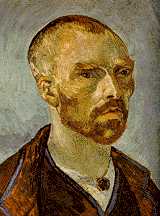 Modern expressionism stems directly from the tragic Dutchman, Vincent van
Gogh (1853 - 1890), a man a little older than Georges Seurat, who died
a year before Seurat did. Both stemming from impressionism, these contemporaries
could hardly be more unlike - Seurat with his calculation, his method,
his deliberation, van Gogh with his passion, his shattering vehemence.
Modern expressionism stems directly from the tragic Dutchman, Vincent van
Gogh (1853 - 1890), a man a little older than Georges Seurat, who died
a year before Seurat did. Both stemming from impressionism, these contemporaries
could hardly be more unlike - Seurat with his calculation, his method,
his deliberation, van Gogh with his passion, his shattering vehemence.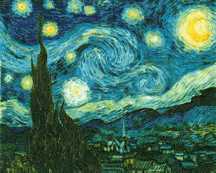 Instead of La Grande Jatte (see Seurat), so cool, so defined, so
self contained, van Gogh gives us The Starry Night, where a whirling
force catapults across the sky and writhes upward from the earth, where
planets burst with their own energy and all the universe surges and pulsates
in a release of intolerable vitality.
Instead of La Grande Jatte (see Seurat), so cool, so defined, so
self contained, van Gogh gives us The Starry Night, where a whirling
force catapults across the sky and writhes upward from the earth, where
planets burst with their own energy and all the universe surges and pulsates
in a release of intolerable vitality.
Like
all the most affecting expressionist creations, The Starry Night
seems to have welled forth onto the canvas spontaneously, as if the creative
act were a compulsive physical one beyond the artist's power to restrain.
"Inspiration" as a kind of frenzied enchantment visited upon a painter,
a paroxysm calling forth images only halfwelled, is a justifiable conception
in van Gogh's case, if it is ever justifiable at all.
THE EARLY DAYS
Indeed van
Gogh must have been a much easier man to read about than he was to be around.
Small, ugly and intense, without charm or wit, intelligent but narrow,
socially ackward, ill dressed as a point of honor, tortured by religious
confusions, yearning for affection but egotistical and stubborn, eager
to please but resentful of criticism, he was one of those people who hold
noble ideas too nobly, who offer their love as an embarrassing gift, whom
one would like to like but whose presence is a burden. He seemed incapable
of enjoying himself or of giving pleasure; in all the letters he wrote
-- and he wrote beautifully in them -- there is no indication that he ever
took anything casually for a moment.
The
men of van Gogh's family were traditionally clergymen, but two uncles had
a prosperous gallery in The Hague, which they sold to the international
art dealer Goupil. Through this connection young Vincent, at sixteen, obtained
a place with Goupil, first in The Hague, then in London, and finally in
the main branch of the firm in Paris. But he failed. Never suave, always
opinionated, no friend of the rich, who buy pictures, he ended by irritating
so many customers that he was dismissed. Turning to religion, he failed
at the theological seminary. When he sought to sacrifice himself in service
as a combination evangelist and social worker among miners in a desperately
depressed and gloomy area, he failed. He subjected himself to all
the hardships of his poverty-stricken parishioners -- their miserable quarters,
their abominable diet. He slept on a hard board and a straw mattress when
he could have had a comfortable bed. The miners laughed at him, their children
hooted at him in the streets. Twice in love, he was twice rejected -- once
by his landlady's daughter in London, once by a cousin. Rejected by the
women he wanted to love, rejected by the people he wanted to help, van
Gogh attempted to fulfill himself on both scores by living with and caring
for a prostitute he picked up on the street, ugly, stupid, and pregnant.
This idyll, which could have been inspired by Dostoevski, endured for twenty
months.
It was
not until 1880, when he was twenty-seven years old, that van Gogh decided
to be a painter. He entered this new life not as one enters a profession
but as one accepts a spiritual calling, in foreknowledge of self-sacrifice.
His
will, his compulsion, to paint as a direct expression of self, as a psychological
need quite aside from professional ambition or the will to fame, no matter
what suffering would be involved, sets van Gogh apart from the impressionists,
who had fought stubbornly in the face of every discouragement but had always
been professional painters, careerists. Delacroix had established the idea
of the painter's right to paint as he pleased, to enter into a pitched
battle against entrenched manners of painting; Courbet had continued to
fight, more as an individual than as a member of an organized school with
a leader and henchmen; the impressionists had further abandoned the pre-nineteenth-century
idea of a painter as a craftsman with a product to sell in satisfaction
of a demand, and finally were to succeed in creating a demand by bringing
public taste into line with their standards. But they were professionals.
With van Gogh the balance swings to the other side. Although he yearned
for attention, although he exhibited when he could, and finally managed
to sell one painting, he was not first of all a man making his way in a
profession. He was a man intent on saving his soul, in creating his very
being, by painting pictures.
Van
Gogh had begun to draw at the time of his failure as an evangelist among
the miners, and had attended classes for a while at the academy in Brussels.
He began his serious study as an overage beginner in the academic art school
at The Hague, but did not stay long. He had a cousin there, Anton Mauve,
one of the most popular painters of the day. Mauve was a painter of sentimentalized
humanitarian subjects in the degenerating tradition of the Barbizon school.
The association did not last long, ending as so many of van Gogh's associations
did, in a quarrel. This was also his time of association with the prostitute
Sien, which had become intolerable. Van Gogh left to paint on his own in
the town of Neunen, where his father was now pastor. He puzzled and frightened
the townsfolk; the pastor forbade them to pose for his son.
The
work from this period -- from his first efforts in 1880 until the beginning
of 1886 -- is a continuation of the obsessive humanitarianism that had
lead Vincent into evangelical work, and it has the same excess of gloomy
fervor that had lead to his failure in it. His subjects are poor people,
squalid streets or farms, miners and peasants broken by poverty and toil,
the inmates of almhouses. He draws in crayon or charcoal, and in his paintings
his colors are as depressing as his subjects. His first large, ambitious
composition, of which there are three versions, was The Potato Eaters,
painted in the dismal browns and greenish blacks of the period.
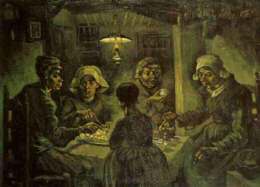 "I
have tried to make it clear how these people, eating their potatoes under
the lamplight, have dug the earth with these very hands they put in the
dish....I am not at all anxious for everyone to like or admire it at once."
"I
have tried to make it clear how these people, eating their potatoes under
the lamplight, have dug the earth with these very hands they put in the
dish....I am not at all anxious for everyone to like or admire it at once."
His taste
in painting generally was also involved more with humanitarian ideas than
with aesthetic values. He admired Millet, and another French painter of
peasants, l'Hermitte, and the Hollander Josef Israels, although he objected
when these men idealized their subjects, as they usually did. He also named
Daumier and Rembrandt, again largely for their subject matter. He read
such English authors as George Eliot and Dickens, who wrote of the poor
and oppressed. The American writer Harriet Beecher Stowe was another favorite;
Uncle Tom's Cabin, with its pathetic slaves, stirred him deeply.
He read the sociological realistic novels of Zola. But he also read the
aesthetic de Goncourts. He hardly knew the impressionistic painters at
this time.
Early
in 1886 van Gogh suddenly left Holland for Paris. It seems to have been
an abrupt decision. It was certainly an important one. He had gone to Antwerp
and had studied for a while at the academy there, but found it dull and
restricting. Academic training was intolerable to him because it seemed
divorced from the earthly and simple values he was interested in. But he
was a clumsy draughtsman and he knew it, and he felt the need of stimulation
and excitement from other painters. If he could not tolerate the school
in Antwerp, neither could he go back to working on his own in the backward
rural community. His brother Theo was directing a small gallery in Paris,
a branch of Goupil's. Vincent wrote him that he would be in the Louvre
at a certain hour, and asked Theo to meet him there.
Later,
Theo was to recognize his brother's power as an artist, but at this time
Vincent was only the family problem, a maladjusted and difficult man whose
drawing was nothing more than an emotional stopgap, who was reaching his
middle thirties and could not hold a job, who had shown that he was impractical
and unstable and would have to be either supported or abandoned to the
most desperate circumstances of life, to vagabondage, starvation, the almshouse.
The story of Vincent and Theo from now on is a poignant one. Their letters,
up to Vincent's last unfinished one written just before his suicide, read
like a fine novel and have furnished the material for several poor ones.
In his letters Vincent reveals the gentleness and above all the clarity
of thought that were so rare when he spoke and not at all apparent in his
actions. His torment is equally revealed, and Theo's patience and love.
But in their day-to-day relationships when they were together, Vincent
remained a problem -- stubborn, hypersensitive, and eccentric. Theo's heart
must have sunk when he read Vincent's letter telling of his decision to
come to Paris, but he took his brother into his flat, supported him from
his own limited income, and set about helping him to find his way toward
a solution of his problems.
Theo's
gallery handled work by all of the major impressionists as well as the
standard Salon masters who sold much better. Theo himself, like any good
dealer, was always hunting new talent and had scouted the impressionists
group shows with more sympathy than most dealers risked. Vincent's arrival
coincided with the first impressionists exhibition, when only a few of
the original group were exhibiting and a special room had been given over
to the neo-impressionists, including Seurat with La Grande Jatte.
The impressionists' happy, brightly tinted art did not immediately
affect Vincent. He entered the studio of Cormon, a conventional painter
who gave his students sound training in the imitation of the model. Here,
a grown man among youngsters, Vincent labored industriously, correcting
his drawings until he had erased holes in the paper, irritating everyone,
the class freak. Just how he managed to get accepted in a class limited
to thirty students, with a waiting list, is a question. Theo's position
as a dealer probably helped. Lautrec was among the students and Vincent
came to his studio from time to time, but he was an odd ball in the effervescent
company and after standing hopefully on the sidelines for a while he would
disappear. Lautrec did a sketch of him at a cafe table; it shows a thin,
bearded man leaning forward intently.
The
stimulation and the new ideas Vincent had come to Paris to find, came not
from the young men at Cormon's studio but from the patriarch of the impressionists,
Pissarro, reappearing yet again in his constant role of saint. As he had
done with Cezanne, Pissarro now induced Vincent to abandon his gloomy palette
and turgid shadows for the bright, high-keyed colorism of the impressionists.
But the transformation was more than a technical one; the spirit of Vincent's
art was equally changed. One of his earliest existing drawings, done at
about the time of his decision to work seriously at art, shows, as he described
it in a letter to Theo, ".........miners, men and women, going to the shaft
in the morning through the snow, by a path along a hedge of thorns; shadows
that pass, dimly visible in the twilight. In the background the large constructions
of the mine, and the heaps of clinkers, stand out vaguely against the sky......do
you think the idea good?" Good or bad, the idea was typical of his preoccupation
at that time with the hard lot of common people, full of cold, gloom, and
miserable hardship.
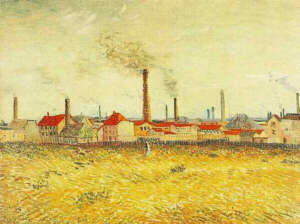 But
now when he paints the Factories at Clichy he has stopped seeing
and thinking in terms of oppressed workers, blackened
chimneys, belching smoke, piles of cinders and slag, and sees instead a
blue sky, red roofs, a foreground of slashing yellows and greens,
all singing in the open air.
But
now when he paints the Factories at Clichy he has stopped seeing
and thinking in terms of oppressed workers, blackened
chimneys, belching smoke, piles of cinders and slag, and sees instead a
blue sky, red roofs, a foreground of slashing yellows and greens,
all singing in the open air.
From
the broken strokes of impressionism and the uniform dots of pointillism
(Vincent had made a brief sally in this latter direction) he developed
a way of painting in short, choppy strokes of bright color, like elongation's
of the pointillist dots, which later were to bend and writhe and to be
reflected also in drawings of the greatest expressive economy. Suddenly
he is an artist, suddenly he is his own man. The
contrast between Old Shoes and the portrait of Pere Tanguy painted
the same year is complete. The old shoes are vigorously painted,
but the color and the implied humanitarianism are still on the dull and
rather heavyhanded that is so bothersome in The Potato Eaters.
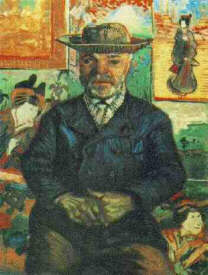 But
Pere Tanguy suddenly lives, as no other of Vincent's images had
lived until then, and Vincent himself suddenly lives as a fulfilled painter.
But
Pere Tanguy suddenly lives, as no other of Vincent's images had
lived until then, and Vincent himself suddenly lives as a fulfilled painter.
Julien
Tanguy, affectionately called Pere Tanguy, was a color grinder who as a
traveling paint salesman had met most of the impressionist during
their most difficult days before 1870. When
he opened his own small shop of artists' materials in Montmartre he began
"buying" their paintings, which usually meant accepting them in exchange
for supplies. He also kept their work on hand for chance sales, and thus
grew into a collector and art dealer. He was particularly fond of Cezanne;
during the years of Cezanne's obscurity as a voluntary exile in Aix, his
paintings could be seen only at Pere Tanguy's. There were times when Monet
and Sisley would have been without materi als to paint with if it had not
been for this fatherly man. Madame Tanguy did not share his confidence
or his interest in those painters who, like van Gogh, used a great deal
of paint but were totally unsaleable.
In February,
1888, Vincent van Gogh left paris for Arles, in the south of France, where
his impressionism exploration was to begin in earnest.
ARLES, SAINT-REMY, AND AUVERS
The events of van Gogh's life between his departure from Paris in early
1888 until his suicide in July, 1890, are well enough known to have established
him in the popular mind as the archetype of the Mad Genius. Not mad, he
was an unstable personality who in the last two years of his life was subject
to epileptic seizures. Not quite a genius, he was a painter who in his
last two years produced a life work of extremist originality, combining
theory with a high degree of personal emotionalism. Because the events
of his life are dramatic enough to be disproportionately intrusive in a
discussion of his painting, they must be summarized first:
Vincent
left Paris in a fit of despondency to which many factors contributed. He
was irritated with the squabbling and bickering that, he found, was the
form usually taken by the stimulating discussions he had hoped for among
painters. Not only was he dependent on his brother Theo, but he felt that
he was in his way -- and he was. And in any case, Paris in February is
not a cheerful city in the low-income bracket. For a painter who had suddenly
discovered color it was gray, its studios dreary. By temperament Vincent
was restless. He had lived his life feeling that what he was hunting was
just around the corner. This time he thought it lay in the brilliant sun
and the simpler life of a small Provencal city. And this time it did.
Theo
gave him an allowance and he set himself up in Arles. For this man of thirty-five
it was like a youth's first discovery of the world on his own. Before long
he was working so hard that he had several fainting spells. Or perhaps
these were the first indication of the malady that was about to make itself
apparent. It was also just the time of the arrival in Arles of the painter
Gauguin.
Gauguin
was a fantastic and to van Gogh a glamorous personality, with barbarous
and brutal good looks the ugly little man must have envied, and an established
reputation among avant-garde painters. The men had met in Paris but did
not know one another very well in spite of Vincent's strong attraction
toward Gauguin. Gauguin was somewhat older, and there is a hint of adolescent
hero worship in van Gogh's feeling for him. He urged Gauguin to visit him
in Arles; Gauguin finally consented. As far as their painting was concerned
there was an important mutual influence. As far as their life together
was concerned there were tensions beyond endurance, at least beyond Vincent's,
and in an incident that apparently will never be clarified in its
details there was a violent quarrel, after which Vincent went to his room,
cut off an ear, wrapped it up, and delivered it to one of the girls in
a brothel that he had frequented with Gauguin. This was during the last
weeks of 1888. Shortly before, he had painted a self portrait as a present
for Gauguin (top of page); the words "a' mon ami Paul" are still
faintly discernible along the upper left border. The Arles experience had
begun with the happiest period of van Gogh's life; but the face in the
self-portrait for Gauguin is already the face of a man pushed to the limits
of endurance, and the remainder of Vincent's life was torment beyond anything
he had endured before.
During
the first five months of 1889 he remained in Arles, with intermittent periods
in the hospital as his seizures recurred. He suffered hallucinations, and
his irrational behavior got him into trouble with the townspeople, as had
happened elsewhere. Then for a year -- May 1889 to May 1890 -- he was an
inmate of the asylum at Saint-Remy, near by, where he had comparative freedom
and could receive immediate treatment - of a kind - during seizures. He
worked passionately. The Starry Night was painted at Saint-Remy.
By May
the seizures seem to have relented and he was thought well enough to return
to the north. He went to Auvers, not far from Paris, where Pissarro lived
and had worked with Cezanne. Pissarro would have taken Vincent into his
own house but his wife, understandably objected. The immediate reason for
the choice of Auvers was the presence there of Dr. Paul Gachet, a physician
who had special
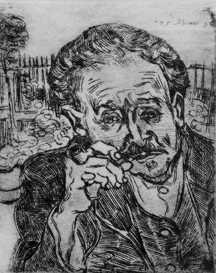 qualifications
for this special case since he was a friend of Pissarro's and Cezanne's
and some of the other impressionists - whom he had frequently treated without
a fee - and was as interested in art as he was medicine.
qualifications
for this special case since he was a friend of Pissarro's and Cezanne's
and some of the other impressionists - whom he had frequently treated without
a fee - and was as interested in art as he was medicine.
In Auvers Vincent
experienced no further seizures. He made occasional short visits to Paris,
saw Lautrec there once more, and went to the Salon and exhibitions, but
he could not take much of Paris at a time. In Auvers he painted constantly.
Dr. Gachet was a miracle of encouragement. But Vincent feared a recurrence
of the dreadful experiences in Arles and Saint-Remy. His consciousness
of the burden his life imposed on his brother was extreme, exaggerated
now because Theo had married and had just had a son.
Vincent
had come to Auvers in May. Near the end of July he began a letter to Theo
in which two sentences are particularly revealing of the nature of his
art and his relationship to it:
"Really, we can speak
only through our paintings.
"In my own work I am risking
my life, and half my reason has been lost in it."
He did not
finish the letter. It was not a "suicide note," although parts of it are
a summation of his relationship with Theo and have about them an air of
finality. But when he stopped the letter in the middle and went out with
his paintbox and his canvas he might have gone out to paint. The revolver
with which he shot himself was never identified. He might have barrowed
it on the way from a peasant, with the excuse that he would use it to shoot
at the crows that were a nuisance in the fields. He shot himself below
the heart, but managed to walk back to the inn where he was staying. Contrary
to the circumstances as usually taken for granted, he did not shoot himself
during an attack or in anticipation of one, and during the two days before
he died he was lucid. Theo had been reached, and Vincent died in his arms.
LATER WORK
The bulk
of van Gogh's life work, the paintings that poured out during the two years
and five months between his arrival in Arles and his suicide in Auvers,
must be more familiar to a wider public today than the work of any other
single painter. At least this is true in the United States. There are individual
paintings such as Whistler's Mother and the Mona Lisa. The Blue
Boy and a Corot or two, that are better known, but in Vincent's case
it is not a matter of one or two paintings. Half his work must have been
reproduced in tens of thousands of color prints, offered in portfolios
as inducements to subscribe to newspapers, framed up assembly-line fashion
for sale in department stores and drug stores. To a vast audience on the
fringe of "appreciation" he is synonymous with modern art -- to which,
actually, he is an excellent introduction.
This
does not sound like a tragic art. Tragic art does not appeal to tens of
thousands of people as living-room decoration. Most of the pictures are
genuinely happy ones unless the pathetic associations of the painter's
life are grafted onto them.
An extreme
flatness as far as modeling in light and shade is concerned, or even as
far as the breaking of color is concerned, is characteristic of the Arles
pictures in general, but their surfaces are heavily textured. The background
of L'Arlesienne is a solid yellow, the brilliant yellow that obsesses
 Vincent
now, broken only by the texture of the broad, thick, application Purple,
its complementary, is played against it in the dress, and within the clash
of the two colors the figure is transfixed.
Vincent
now, broken only by the texture of the broad, thick, application Purple,
its complementary, is played against it in the dress, and within the clash
of the two colors the figure is transfixed.
Madame
Ginoux, a neighbor who posed in regional costume for L'Arlesienne,
(left) was one of several friendly people who solved for a while van Gogh's
perpetual model problem. The most obliging of these were the postman Roulin
and his wife. He painted five portraits of Roulin, one of them showing
his uniform in a strong blue against a pale background, with the beard
in short, straight, springing strokes
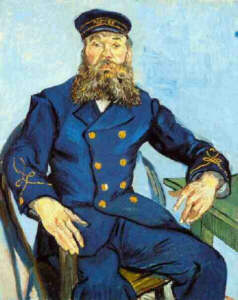 of
brownish and yellowish tints flecked with bits of bright blue and red.
The figure is more three-dimensionally modeled than that of L'Arlesienne,
but in the remarkable portrait of Madame Roulin called La Berceuse
the flatness is again extreme.
of
brownish and yellowish tints flecked with bits of bright blue and red.
The figure is more three-dimensionally modeled than that of L'Arlesienne,
but in the remarkable portrait of Madame Roulin called La Berceuse
the flatness is again extreme.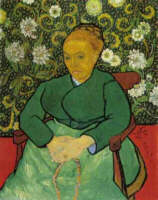 The
picture began with a sentimental idea. It was to recall lullabies to lonely
men, Vincent said, and he compared its colors to common chromolithographs.
The
picture began with a sentimental idea. It was to recall lullabies to lonely
men, Vincent said, and he compared its colors to common chromolithographs.
After
the crisis of his first attacks, his break with Gauguin, and finally his
transfer to the asylum at Saint-Remy, Vincent's paintings take on the swirling,
tempestuous form and the more mystical expression of which The Starry
Night is a climatic expression. But they are interspersed with milder
expressions, such as The Road Menders, where the warm tones and
the everyday subject modify and even for a moment conceal the compulsive
writhing of the great trees.
In the
case of van Gogh, the compulsion to paint is inescapable. anyone can accept
the idea that painting is an emotional release for a man who fits in nowhere
else. Since Vincent's time the idea has even been so abused that art schools
are filled with students whose only qualification as potential artists
consists of a demonstrated lack of qualification for being anything else.
What a shame that this too is part of Vincent's legacy.
BACK TO HOME PAGE
E-Mail: [email protected]


 Modern expressionism stems directly from the tragic Dutchman, Vincent van
Gogh (1853 - 1890), a man a little older than Georges Seurat, who died
a year before Seurat did. Both stemming from impressionism, these contemporaries
could hardly be more unlike - Seurat with his calculation, his method,
his deliberation, van Gogh with his passion, his shattering vehemence.
Modern expressionism stems directly from the tragic Dutchman, Vincent van
Gogh (1853 - 1890), a man a little older than Georges Seurat, who died
a year before Seurat did. Both stemming from impressionism, these contemporaries
could hardly be more unlike - Seurat with his calculation, his method,
his deliberation, van Gogh with his passion, his shattering vehemence. Instead of La Grande Jatte (see Seurat), so cool, so defined, so
self contained, van Gogh gives us The Starry Night, where a whirling
force catapults across the sky and writhes upward from the earth, where
planets burst with their own energy and all the universe surges and pulsates
in a release of intolerable vitality.
Instead of La Grande Jatte (see Seurat), so cool, so defined, so
self contained, van Gogh gives us The Starry Night, where a whirling
force catapults across the sky and writhes upward from the earth, where
planets burst with their own energy and all the universe surges and pulsates
in a release of intolerable vitality.
 "I
have tried to make it clear how these people, eating their potatoes under
the lamplight, have dug the earth with these very hands they put in the
dish....I am not at all anxious for everyone to like or admire it at once."
"I
have tried to make it clear how these people, eating their potatoes under
the lamplight, have dug the earth with these very hands they put in the
dish....I am not at all anxious for everyone to like or admire it at once."
 But
now when he paints the Factories at Clichy he has stopped seeing
and thinking in terms of oppressed workers, blackened
chimneys, belching smoke, piles of cinders and slag, and sees instead a
blue sky, red roofs, a foreground of slashing yellows and greens,
all singing in the open air.
But
now when he paints the Factories at Clichy he has stopped seeing
and thinking in terms of oppressed workers, blackened
chimneys, belching smoke, piles of cinders and slag, and sees instead a
blue sky, red roofs, a foreground of slashing yellows and greens,
all singing in the open air.
 But
Pere Tanguy suddenly lives, as no other of Vincent's images had
lived until then, and Vincent himself suddenly lives as a fulfilled painter.
But
Pere Tanguy suddenly lives, as no other of Vincent's images had
lived until then, and Vincent himself suddenly lives as a fulfilled painter.
 qualifications
for this special case since he was a friend of Pissarro's and Cezanne's
and some of the other impressionists - whom he had frequently treated without
a fee - and was as interested in art as he was medicine.
qualifications
for this special case since he was a friend of Pissarro's and Cezanne's
and some of the other impressionists - whom he had frequently treated without
a fee - and was as interested in art as he was medicine.
 Vincent
now, broken only by the texture of the broad, thick, application Purple,
its complementary, is played against it in the dress, and within the clash
of the two colors the figure is transfixed.
Vincent
now, broken only by the texture of the broad, thick, application Purple,
its complementary, is played against it in the dress, and within the clash
of the two colors the figure is transfixed.
 of
brownish and yellowish tints flecked with bits of bright blue and red.
The figure is more three-dimensionally modeled than that of L'Arlesienne,
but in the remarkable portrait of Madame Roulin called La Berceuse
the flatness is again extreme.
of
brownish and yellowish tints flecked with bits of bright blue and red.
The figure is more three-dimensionally modeled than that of L'Arlesienne,
but in the remarkable portrait of Madame Roulin called La Berceuse
the flatness is again extreme. The
picture began with a sentimental idea. It was to recall lullabies to lonely
men, Vincent said, and he compared its colors to common chromolithographs.
The
picture began with a sentimental idea. It was to recall lullabies to lonely
men, Vincent said, and he compared its colors to common chromolithographs.
